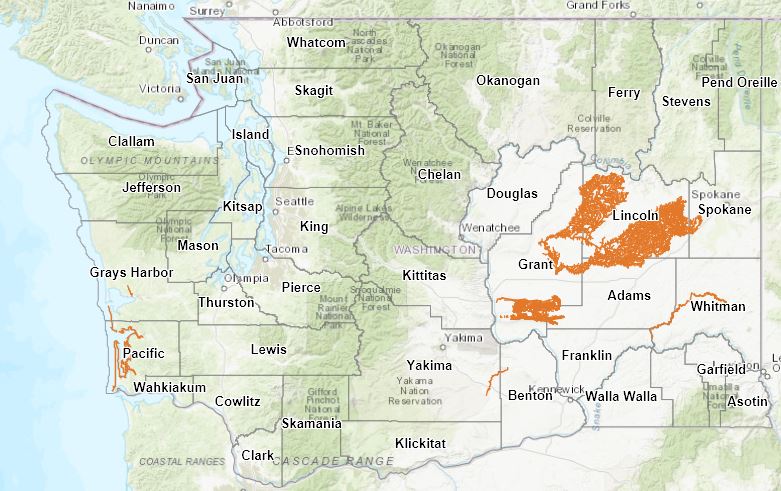Mineral prospecting and placer mining
Ensuring wastewater meets water quality standards is important to protect the health of surface water, groundwater, and aquatic life. Using water quality permits, we manage when, where, how, and if wastewater enters the environment.
Effective June 11, 2020, RCW 90.48.615 prohibits motorized and gravity siphon aquatic mining in some locations where it has historically taken place. It also mandates new permitting requirements. We're partnering with the Washington Department of Fish and Wildlife (WDFW) to implement these changes.
New law to protect salmonid habitat
RCW 90.48.615 went into effect June 11, 2020. Beginning this date, motorized and gravity siphon aquatic mining is prohibited in waters of the state that are critical habitat under the Endangered Species Act (ESA) for salmon, steelhead, or bull trout, and all fresh waters of the state with designated uses of salmonid spawning, rearing, and migration.

Suction dredging in a river, like shown in this photo, is prohibited in areas to protect salmonid habitat.
Why is this important?
Motorized mining activities can cause habitat disruption, creating suspended sediment in the river and smothering salmon spawning gravel and incubating salmon eggs. This can lead to fewer juvenile salmon surviving, decreases the amount of adult fish available for harvest, and impacts food sources for other animals such as orcas.
What's changed?
- Motorized and gravity siphon aquatic mining in waters of the state that are designated as critical habitat for salmon, steelhead, or bull trout under ESA or with designated uses of salmonid spawning, rearing, and habitat is prohibited.
- In addition to receiving a Hydraulic Project Approval (HPA) permit from WDFW, prospectors must apply for and be issued an individual National Pollution Discharge Elimination System (NPDES) water quality permit from Ecology. We may issue individual permits to prospectors who are:
- Working outside of salmonid habitat (see map).
- Returning effluent (water) from the mining activity back to the water body or to the ground.
- When prospectors apply for a HPA permit with WDFW, they will need to submit proof of compliance with the Clean Water Act as part of a complete application. This will be in the form of a NPDES permit or a letter from Ecology indicating that a permit is not required.
What's allowed vs. prohibited?
Motorized and gravity siphon aquatic mining may still be allowed in areas that are not salmonid habitat (see map).
In salmonid habitat areas, non-motorized mining activities, such as gold panning, are the only form of mining allowed. These activities do not require an individual NPDES permit from Ecology, but will still require a HPA from WDFW.
| Location | Motorized and Gravity Siphon Aquatic Mining | Non-Motorized Methods |
|---|---|---|
| Prohibited area | Not allowed | Allowed – HPA permit or Gold and Fish pamphlet coverage |
| Mining potential use area* | Allowed with NPDES permit and HPA permit | Allowed – HPA permit or Gold and Fish pamphlet coverage |
*Potential use areas are areas outside of salmonid habitat and where Ecology may issue individual NPDES permits pending application review.
Read our Frequently Asked Questions for more information.
How do I apply for permits?
- Determine if you are within a mining potential use area (see map)
- Apply for an individual National Pollutant Discharge Elimination System (NPDES) permit from Ecology. This permit includes the requirements you must follow in order to discharge water to surface water bodies, like lakes or streams, or to the ground during the mining process. Please note that you must apply for the NPDES permit at least 180 days prior to the start date of mining operation. We cannot issue NPDES permits for motorized and gravity siphon aquatic mining in critical salmon areas.
- Apply for a HPA permit from WDFW: For more information about WDFW’s permits, please refer to their rules for mineral prospecting and placer mining webpage.
What if I have a current HPA permit?
As of June 11, 2020 you will need both a HPA and a NPDES permit to legally conduct motorized or gravity siphon aquatic mining activities.
Map of Mining Potential Use Areas
Possible locations where motorized aquatic mining may be allowed in Adams, Benton, Clallam, Grant, Grays Harbor, Lincoln, Pacific, Spokane, Whitman, and Yakima counties. Visit the interactive map.
Related links
Contact information
Mark Peterschmidt
Watershed Unit Supervisor
mark.peterschmidt@ecy.wa.gov
509-454-7843


